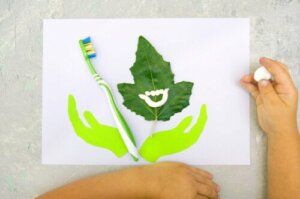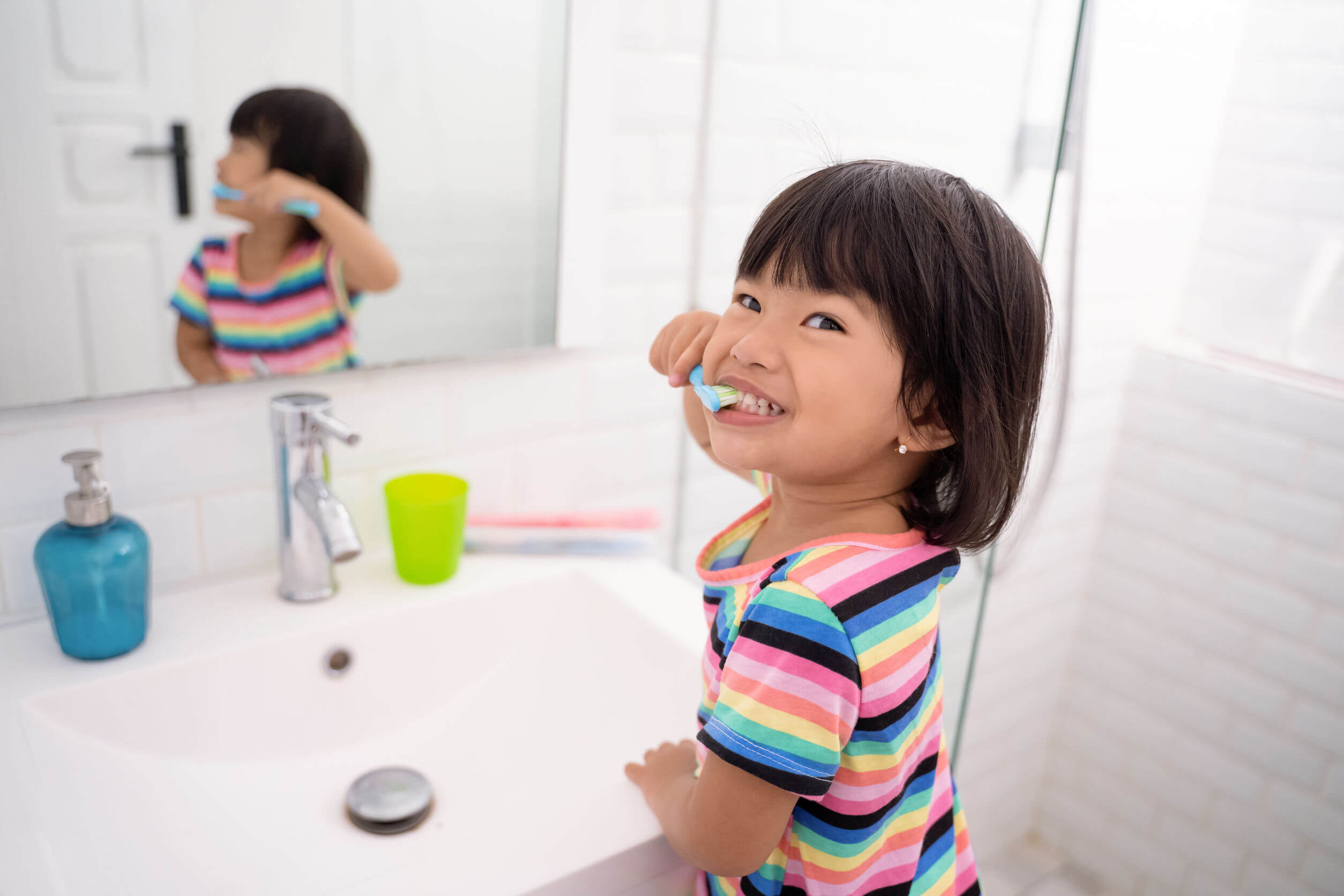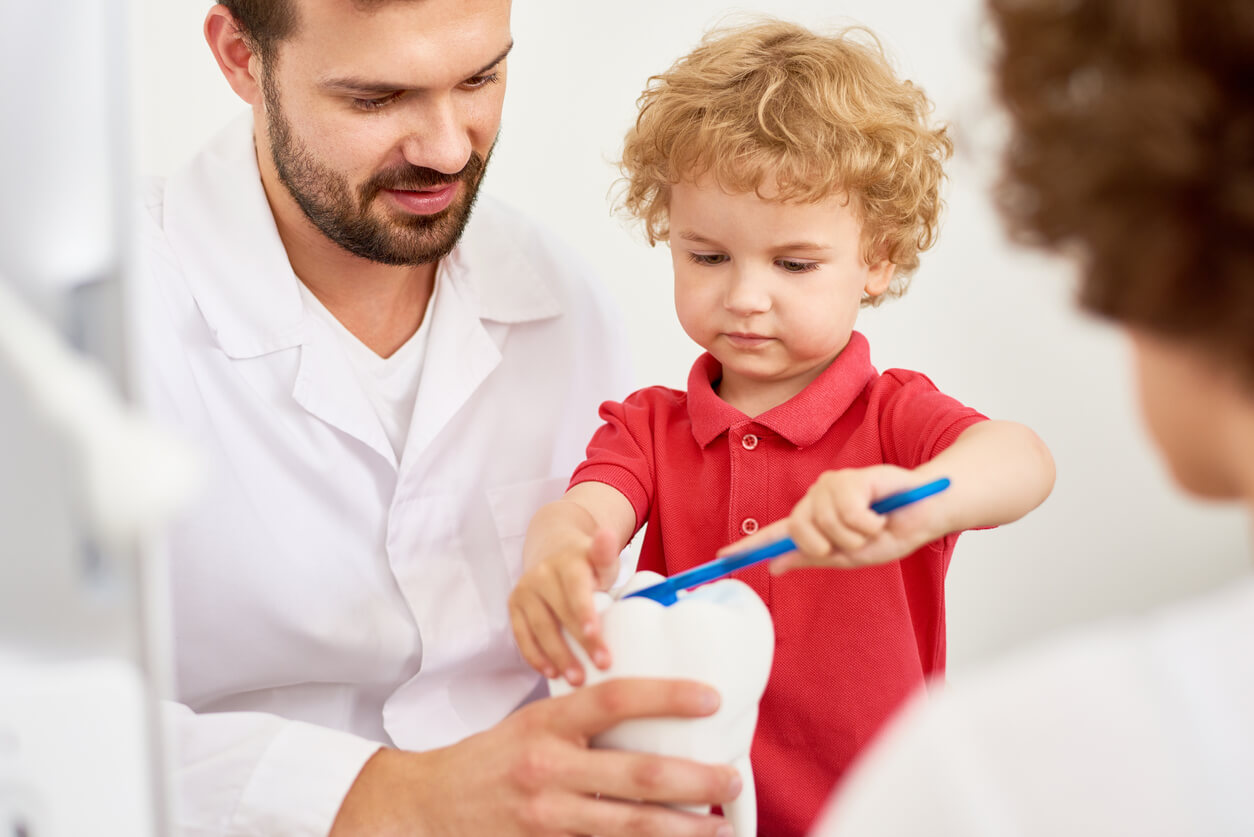The Montessori Method for Teaching Children to Brush Their Teeth

For some parents, when it comes time to tend to the dental hygiene of their little ones, things can get quite complicated. But the fact that children start taking care of their mouths from an early age will make a difference in their overall health in the medium and long term. For this reason, today, we’re going to share with you an alternative technique based on the Montessori method to teach children to brush their teeth.
Taking inspiration from this pedagogy may be the key to making toothbrushing time more interesting. In addition, it’s very effective in helping make toothbrushing a habit that’s acquired voluntarily and without impositions. Keep reading to find out all about it.
The Montessori Method
Montessori pedagogy is an educational model created by the Italian physician and educator Maria Montessori. It promotes the development of independence and freedom of infants within certain limits, but always with respect for individual physical, social, and psychological processes.
In this model of education, the emphasis is on child-directed activities. With that in mind, the adult fulfills the role of an external guide who facilitates autonomous discovery. They’re the ones who are in charge of adapting the conditions of the environment so that it’s safe and stimulating, and thus, little ones can unfold their full potential and achieve autonomous learning.
The environment where children plays has a key role in this philosophy and must be adapted to their stage of development. This space has to be aesthetic, orderly, simple, and real. Each element that makes it up has to be there with a clear purpose and favor the actions and thoughts of the children in question.
All these elements are of the utmost importance when it comes to achieving the adequate comprehensive development of little ones, as well as sparking a genuine interest in and a greater commitment to what they do.
How can you use the Montessori method to teach your children to brush their teeth?
The moment of dental hygiene can be unpleasant and feel like a waste of time for many infants. For this reason, it’s common for little ones to refuse to brush their teeth.
However, inadequate oral hygiene has a negative impact on children’s health. Tooth decay, swollen gums, or bad breath are just some of the annoying consequences of not brushing your teeth, and these end up affecting your quality of life. For this reason, parents have to find the most appropriate way for their children to gain interest in carrying out this activity.
The Montessori method can be an interesting and respectful philosophy for you to teach your child to brush their teeth in the best way. In the following paragraphs, we’ll share the steps you should consider in order to put it into practice in your home today.
Prepare the environment
For your child to feel that they actively participate in the care of their body, they must have everything they require within their reach. According to the Montessori method, accessibility is a fundamental component of autonomous learning.
In the case of oral hygiene, this means that your child has a special space, at their level, where they have everything they need to clean their mouth: A glass, toothpaste, a toothbrush, and a mirror to look at themselves and familiarize themselves better with routine.

Guide the process
As we already mentioned, according to this philosophy, adults act as observers and guides of children’s learning processes. Therefore, parents should help their children to brush their teeth by example.
Little ones need to be told how to perform the movements and what to take into account in order to carry out proper oral hygiene. Showing the technique in slow motion is a good idea to achieve this.
Also, watching their parents carrying out the oral hygiene of their own mouths and then letting them do it in theirs is a timely way for children to learn. This participation of adults in cleaning ensures that it’s effective, as small children don’ have sufficient motor skills to do it on their own.
Around the age of 6 or 8, the children will be the protagonists of the care of their mouths and their parents will limit themselves to supervising the process. Even if they don’t have a proper technique yet, with practice and interest, they will.
Use routine tables
Routine tables are tools widely used by the Montessori method. These elements help the child to organize and be attentive to the activities that must be carried out each day.
Including the moment of tooth brushing among the tasks will encourage your little one to consider this activity as part of their daily life. Ideally, you should do it when you wake up, after eating, and before going to bed.
Using time sequences for the tooth brushing process
Using images of the dental hygiene sequence is a useful tool to teach your child to brush their teeth, according to the Montessori method. Illustrating what to do, step by step, reinforces learning.
Using drawings or pictograms showing the whole process and sticking it in the bathroom is a good idea. These may include the following steps:
- Put the toothpaste on the brush.
- Brush the outside of the bottom teeth.
- Clean the inside of the lower teeth.
- Sanitize the chewing surface of the lower teeth.
- Brush the outside of your upper teeth.
- Clean the inside of the upper teeth.
- Sanitize the chewing surface of the upper teeth.
- Remember to clean the tongue.
- Spit.
- Wash the toothbrush and put it away.
Use games to practice brushing
Learning through play is another way to help your child brush their teeth, according to the Montessori method. Offering activities and resources that teach or encourage the practice of this activity promote its incorporation into the routine.
Drawings of the mouth with arrows that indicate the direction in which the brush should move, toy dentures to practice brushing, or even the mouth of the parents so that the children can clean them are some options. All the playful tools you can think of will be useful in getting little ones interested in caring for their mouths.

Keeping your mouth healthy is an everyday job
Oral health care isn’t limited to tooth brushing but also includes maintaining a healthy diet and visiting the dentist regularly.
The Montessori method can be a great ally for you to teach your children to brush their teeth and understand the importance of taking care of their oral health.
Incorporating these habits from an early age and making the little ones part of the care of their own body will make them feel responsible and autonomous. And so, you’ll provide them with learning that will accompany them throughout their lives.
For some parents, when it comes time to tend to the dental hygiene of their little ones, things can get quite complicated. But the fact that children start taking care of their mouths from an early age will make a difference in their overall health in the medium and long term. For this reason, today, we’re going to share with you an alternative technique based on the Montessori method to teach children to brush their teeth.
Taking inspiration from this pedagogy may be the key to making toothbrushing time more interesting. In addition, it’s very effective in helping make toothbrushing a habit that’s acquired voluntarily and without impositions. Keep reading to find out all about it.
The Montessori Method
Montessori pedagogy is an educational model created by the Italian physician and educator Maria Montessori. It promotes the development of independence and freedom of infants within certain limits, but always with respect for individual physical, social, and psychological processes.
In this model of education, the emphasis is on child-directed activities. With that in mind, the adult fulfills the role of an external guide who facilitates autonomous discovery. They’re the ones who are in charge of adapting the conditions of the environment so that it’s safe and stimulating, and thus, little ones can unfold their full potential and achieve autonomous learning.
The environment where children plays has a key role in this philosophy and must be adapted to their stage of development. This space has to be aesthetic, orderly, simple, and real. Each element that makes it up has to be there with a clear purpose and favor the actions and thoughts of the children in question.
All these elements are of the utmost importance when it comes to achieving the adequate comprehensive development of little ones, as well as sparking a genuine interest in and a greater commitment to what they do.
How can you use the Montessori method to teach your children to brush their teeth?
The moment of dental hygiene can be unpleasant and feel like a waste of time for many infants. For this reason, it’s common for little ones to refuse to brush their teeth.
However, inadequate oral hygiene has a negative impact on children’s health. Tooth decay, swollen gums, or bad breath are just some of the annoying consequences of not brushing your teeth, and these end up affecting your quality of life. For this reason, parents have to find the most appropriate way for their children to gain interest in carrying out this activity.
The Montessori method can be an interesting and respectful philosophy for you to teach your child to brush their teeth in the best way. In the following paragraphs, we’ll share the steps you should consider in order to put it into practice in your home today.
Prepare the environment
For your child to feel that they actively participate in the care of their body, they must have everything they require within their reach. According to the Montessori method, accessibility is a fundamental component of autonomous learning.
In the case of oral hygiene, this means that your child has a special space, at their level, where they have everything they need to clean their mouth: A glass, toothpaste, a toothbrush, and a mirror to look at themselves and familiarize themselves better with routine.

Guide the process
As we already mentioned, according to this philosophy, adults act as observers and guides of children’s learning processes. Therefore, parents should help their children to brush their teeth by example.
Little ones need to be told how to perform the movements and what to take into account in order to carry out proper oral hygiene. Showing the technique in slow motion is a good idea to achieve this.
Also, watching their parents carrying out the oral hygiene of their own mouths and then letting them do it in theirs is a timely way for children to learn. This participation of adults in cleaning ensures that it’s effective, as small children don’ have sufficient motor skills to do it on their own.
Around the age of 6 or 8, the children will be the protagonists of the care of their mouths and their parents will limit themselves to supervising the process. Even if they don’t have a proper technique yet, with practice and interest, they will.
Use routine tables
Routine tables are tools widely used by the Montessori method. These elements help the child to organize and be attentive to the activities that must be carried out each day.
Including the moment of tooth brushing among the tasks will encourage your little one to consider this activity as part of their daily life. Ideally, you should do it when you wake up, after eating, and before going to bed.
Using time sequences for the tooth brushing process
Using images of the dental hygiene sequence is a useful tool to teach your child to brush their teeth, according to the Montessori method. Illustrating what to do, step by step, reinforces learning.
Using drawings or pictograms showing the whole process and sticking it in the bathroom is a good idea. These may include the following steps:
- Put the toothpaste on the brush.
- Brush the outside of the bottom teeth.
- Clean the inside of the lower teeth.
- Sanitize the chewing surface of the lower teeth.
- Brush the outside of your upper teeth.
- Clean the inside of the upper teeth.
- Sanitize the chewing surface of the upper teeth.
- Remember to clean the tongue.
- Spit.
- Wash the toothbrush and put it away.
Use games to practice brushing
Learning through play is another way to help your child brush their teeth, according to the Montessori method. Offering activities and resources that teach or encourage the practice of this activity promote its incorporation into the routine.
Drawings of the mouth with arrows that indicate the direction in which the brush should move, toy dentures to practice brushing, or even the mouth of the parents so that the children can clean them are some options. All the playful tools you can think of will be useful in getting little ones interested in caring for their mouths.

Keeping your mouth healthy is an everyday job
Oral health care isn’t limited to tooth brushing but also includes maintaining a healthy diet and visiting the dentist regularly.
The Montessori method can be a great ally for you to teach your children to brush their teeth and understand the importance of taking care of their oral health.
Incorporating these habits from an early age and making the little ones part of the care of their own body will make them feel responsible and autonomous. And so, you’ll provide them with learning that will accompany them throughout their lives.
All cited sources were thoroughly reviewed by our team to ensure their quality, reliability, currency, and validity. The bibliography of this article was considered reliable and of academic or scientific accuracy.
- Gómez Lara, M. S. (2018). Educación y los procesos metodológicos de la enseñanza aprendizaje en la salud odontológica (Bachelor’s thesis, Quito: UCE).
- Albán Tarambis, J. P., & Vela Rojas, K. M. (2021). El método Montessori en el desarrollo integral de los niños/as de 4 a 5 años (Bachelor’s thesis, Quito: UCE).
- Mona, D., & Azalea, F. W. (2018). Leaflet and pocketbook as an education tool to change level of dental health knowledge. dental hygiene, 8, 9.
- Quispe Peralta, M. (2019). El método Montessori aplicado para los alumnos de educación inicial.
- Sinha, M., & Deb, S. (2017, September). An interactive elementary tutoring system for oral health education using an augmented approach. In IFIP Conference on Human-Computer Interaction (pp. 413-430). Springer, Cham.
- Duarte Gómez, Y. C., Naranjo Burgos, D., & Puentes Garzón, A. M. (2018). Aplicación de estrategias lúdicas pedagógicas para mejorar el aseo e higiene bucal de los niños y niñas del grado transición de 4 a 5 años en el jardín Dulce Corazón de María del Municipio de Girardot-Cundinamarca (Doctoral dissertation, Corporación Universitaria Minuto de Dios).
- Heras Solís, J. E., & Velásquez Amén, B. E. (2020). Aplicación de método Montessori en infantes con discapacidad intelectual leve: área sensorial y habilidades cognitivas, estudio realizado en Escuela Particular Lidia Deán de Henríquez (Doctoral dissertation, Universidad de Guayaquil. Facultad de Ciencias Médicas. Carrera de Tecnología Médica).
- Gómez Paredes, A., & Vásquez Mina, C. S. (2019). El método Montessori como estrategia pedagógica para mejorar la motivación en niños y niñas de 2 a 3 años.
- Muñoz, B. M. (2018). Montessorízate: Criar siguiendo los principios Montessori. Grijalbo.
- Alarcón, E. (2016). Influencia Del Método Montessori En Educación Física Y Salud (Doctoral dissertation, Doctoral dissertation, UNIVERSIDAD AUSTRAL DE CHILE).
This text is provided for informational purposes only and does not replace consultation with a professional. If in doubt, consult your specialist.








